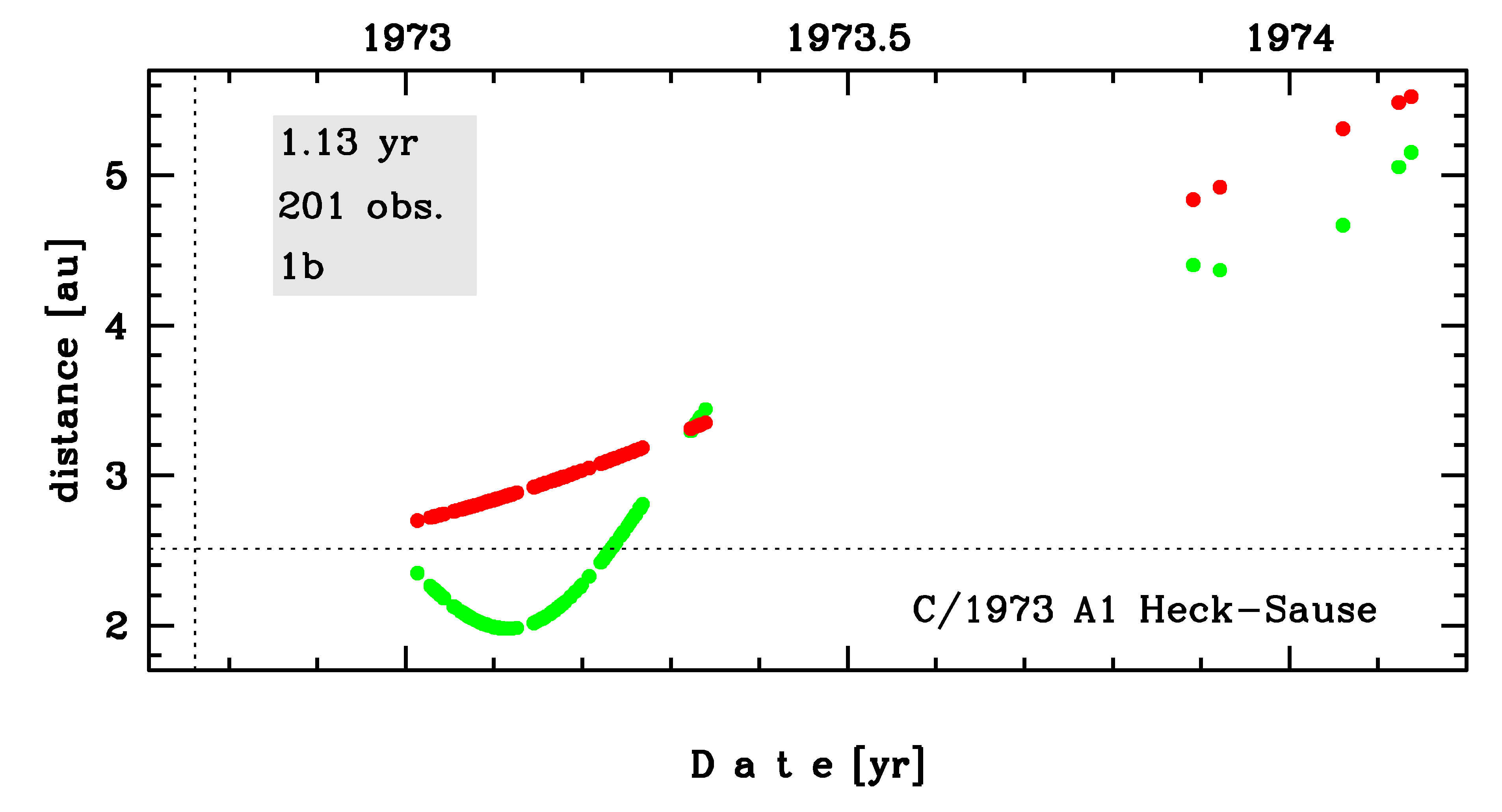C/1973 A1 Heck-Sause
more info
Comet C/1973 A1 was discovered on 11 January 1973 by André Heck and Gérard Sause (Haute Provence Observatory, France), that is more than 3 months after its perihelion passage.In the next few months prediscovery images were found taken on 4 January (Sendai Municipal Observatory, Japan) and 10 January (Montpellier, France). This comet was observed until 26 February 1974 [Kronk, Cometography: Volume 5].
Comet had its closest approach to the Earth on 11 February 1973 (1.978 au), a month after its discovery.
Solution given here is based on post-perihelion data spanning over 1.13 yr in a range of heliocentric distances from 2.70 au to 5.53 au.
This Oort spike comet suffers rather small planetary perturbations during its passage through the planetary system; these perturbations lead to a more tight future orbit.
See also Królikowska 2020.
Comet had its closest approach to the Earth on 11 February 1973 (1.978 au), a month after its discovery.
Solution given here is based on post-perihelion data spanning over 1.13 yr in a range of heliocentric distances from 2.70 au to 5.53 au.
This Oort spike comet suffers rather small planetary perturbations during its passage through the planetary system; these perturbations lead to a more tight future orbit.
See also Królikowska 2020.
| solution description | ||
|---|---|---|
| number of observations | 201 | |
| data interval | 1973 01 04 – 1974 02 19 | |
| data type | observed only after perihelion (POST) | |
| data arc selection | entire data set (STD) | |
| range of heliocentric distances | 2.7 au – 5.53au | |
| detectability of NG effects in the comet's motion | NG effects not determinable | |
| type of model of motion | GR - gravitational orbit | |
| data weighting | YES | |
| number of residuals | 400 | |
| RMS [arcseconds] | 1.24 | |
| orbit quality class | 1b | |
| next orbit statistics, both Galactic and stellar perturbations were taken into account | ||
|---|---|---|
| no. of returning VCs in the swarm | 5001 | * |
| no. of escaping VCs in the swarm | 0 | |
| no. of hyperbolas among escaping VCs in the swarm | 0 | |
| next reciprocal semi-major axis [10-6 au-1] | 362.88 – 378.33 – 394.11 | |
| next perihelion distance [au] | 2.51452 – 2.51457 – 2.5146 | |
| next aphelion distance [103 au] | 5.07 – 5.28 – 5.51 | |
| time interval to next perihelion [Myr] | 0.127 – 0.135 – 0.144 | |
| percentage of VCs with qnext < 10 | 100 | |
| next_g orbit statistics, here only the Galactic tide has been included | ||
|---|---|---|
| no. of returning VCs in the swarm | 5001 | * |
| no. of escaping VCs in the swarm | 0 | |
| no. of hyperbolas among escaping VCs in the swarm | 0 | |
| next reciprocal semi-major axis [10-6 au-1] | 362.90 – 378.34 – 394.13 | |
| next perihelion distance [au] | 2.5093 – 2.50956 – 2.50978 | |
| next aphelion distance [103 au] | 5.07 – 5.28 – 5.51 | |
| time interval to next perihelion [Myr] | 0.127 – 0.135 – 0.144 | |
| percentage of VCs with qnext < 10 | 100 | |
